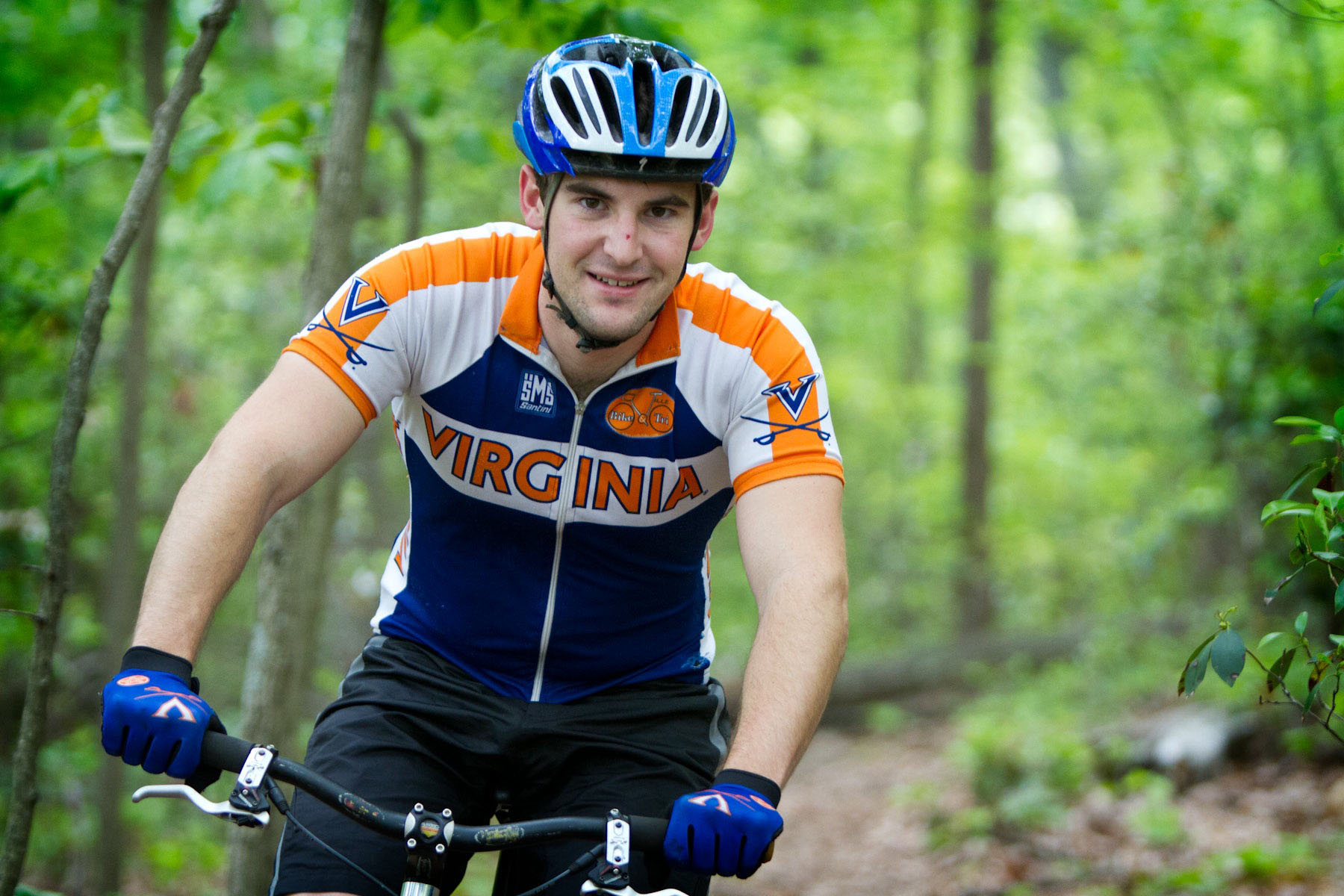May 2, 2012 — Whether it's an old building or a bike trail, William Canup likes to explore.
The Richmond native, now a University of Virginia Lawn resident, grew up in Richmond's historic Forest Hill neighborhood, surrounded by notable old homes and buildings and easy access to off-road bike paths in the woods nearby.
One day he spied a bike race on one of the trails and was hooked. He founded the mountain bike club at his high school, the Maggie L. Walker Governor's School for Government and International Studies, and was drawn to U.Va. because he knew it had a great academic reputation and, equally important, a bike club and easy access to the lush surrounding countryside and the Blue Ridge Mountains.
The Cycling Club at U.Va. was "geared to road biking," Canup said. So he created the club's competitive mountain bike team, which competes weekends on trails near campuses throughout the region.
"It's a great way to explore trails around other schools and meet others interested in biking," he said of the courses that can run anywhere from 15 to 30 miles, depending on whether the terrain is flat or hilly.
In 2011 – in just its second year of competition – the team placed third in Division One of the Atlantic Collegiate Cycling Conference. Canup himself placed second overall for the 2011 season and went on, along with fellow team member and fourth-year environmental sciences major Timothy Price, to the national championships in Angel Fire, N.M.
Canup, a member of the Raven Society, which acknowledges academic scholarship and commitment to the University, also finds fun in the scholarly side of his life. Not worried about what he would eventually choose as a major, he entered the College of Arts & Sciences and explored courses ranging from studio art to astronomy and politics to philosophy. The ones that he found had the most impact were in the School of Architecture and it quickly became clear that architectural history was a perfect fit.
"I love studying and exploring the built environment around me," Canup said. Transferring into the School of Architecture "also has enabled me to take courses in many other tangential topics, like 3-D modeling and landscape design."
He put his knowledge of 3-D modeling to the test when he joined a group in U.Va.'s Institute for Advanced Technology in the Humanities working with the Colonial Williamsburg Foundation to create "Virtual Williamsburg," a digital project that seeks to present Williamsburg as it appeared in 1776. The modeling software tools he used enabled the accurate representation of wood grains and brick coursing and other details for the re-creation. "The experience was fascinating," Canup said.
On a study-abroad semester with the Institute for the International Education of Students, known as IES Abroad, Canup had an internship at the American Academy in Rome, the oldest American overseas center for independent study and research in the arts and humanities, where he helped organize and catalog the archeological study collection and researched Rome Prize recipients from 1894 to 1914.
For his thesis project, Canup turned his focus back to Richmond and Byrd Park Pump House on the remains of the James River and Kanawha Canal, where he bikes on nearby trails when he's at home. "Built in 1883, the mechanical system was on the first floor and on the second floor, a dance hall. It's a special little gem that is a bit off the beaten track," he said.
He shared some preliminary research on a class trip to Richmond that focused on 19th-century American architecture, led by professor Richard Guy Wilson.
"It's more fun to study with a group and get different perspectives," Canup said.
Although Richmond holds a special place in his heart and he hopes eventually to settle there, Canup said a course this spring on historic preservation brought all aspects of architectural history and historic preservation together for him. Taught by almost every member of the Office of the Architect, the course provided a behind-the-scenes peek at issues involved in preservation and restoration.
As part of the course, "Historic Preservation at U.Va," Canup's team made a presentation about Pavilion VIII after reviewing the recent restoration of Pavilion X. Their research revealed that Pavilion VIII's original design had a flat roof with a smaller parapet than Pavilion X, but preserving an 1856 addition would preclude restoring the flat roof. The current pitched roof houses the pavilion's mechanical systems.
"It's about respecting all the history, not just the Jefferson period," Canup said.
Following graduation on May 20, he will participate in a two-month Maine Preservation Fellowship Program in Yarmouth and work with Consigli Construction company on restoration of a couple of churches.
"I'll tag along with the engineers and learn all about the work that goes into bringing back a building," Canup said.
He's already checked out opportunities for mountain biking in the area in his spare time.
– by Jane Ford
# # #
Media Contact
Article Information
May 4, 2012
/content/class-2012-architectural-historian-explores-built-and-natural-environments

